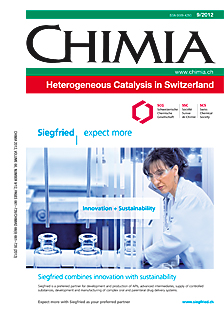Active Sites, Deactivation and Stabilization of Fe-ZSM-5 for the Selective Catalytic Reduction (SCR) of NO with NH3
DOI:
https://doi.org/10.2533/chimia.2012.687Keywords:
Active sites, Deactivation, Fe-zsm-5, Scr, Selective catalytic reduction, StabilizationAbstract
Fe-ZSM-5 has been systematically investigated as catalyst for the selective catalytic reduction (SCR) of NO with NH3, concentrating on the active sites, the deactivation mechanism during hydrothermal aging and the chemical possibilities to stabilize this type of SCR catalyst. Regarding the active SCR sites, it could be shown that monomeric species start to become active at the lowest temperatures (Ea,app ? 36.3 ± 0.2 kJ/mol), followed by dimeric species at intermediate temperatures (Ea,app ? 77 ± 16 kJ/mol) and oligomeric species at high temperatures. Experiments with Fe-ZSM-5 samples, in which the Brønsted acidity was specifically removed, proved that Brønsted acidity is not required for high SCR activity and that NH3 can also be adsorbed on other acidic sites on the zeolite surface. The hydrothermal deactivation of Fe-ZSM-5 could be explained by the migration of active iron ions from the exchange sites. Parallel to the iron migration dealumination of the zeolite framework occurs, which has to be regarded as an independent process. The migration of iron can be reduced by the targeted reaction of the aluminum hydroxide groups in the lattice with trimethylaluminium followed by calcination. With respect to the application of iron zeolites in the SCR process in diesel vehicles, the most efficient stabilization method would be to switch from the ZSM-5 to the BEA structure type. The addition of NO2 to the feed gas is another effective measure to increase the activity of even strongly deactivated iron zeolites tremendously.Downloads
Published
2012-09-26
Issue
Section
Scientific Articles
License
Copyright (c) 2012 Swiss Chemical Society

This work is licensed under a Creative Commons Attribution-NonCommercial 4.0 International License.
How to Cite
[1]
O. Kröcher, S. Brandenberger, Chimia 2012, 66, 687, DOI: 10.2533/chimia.2012.687.







